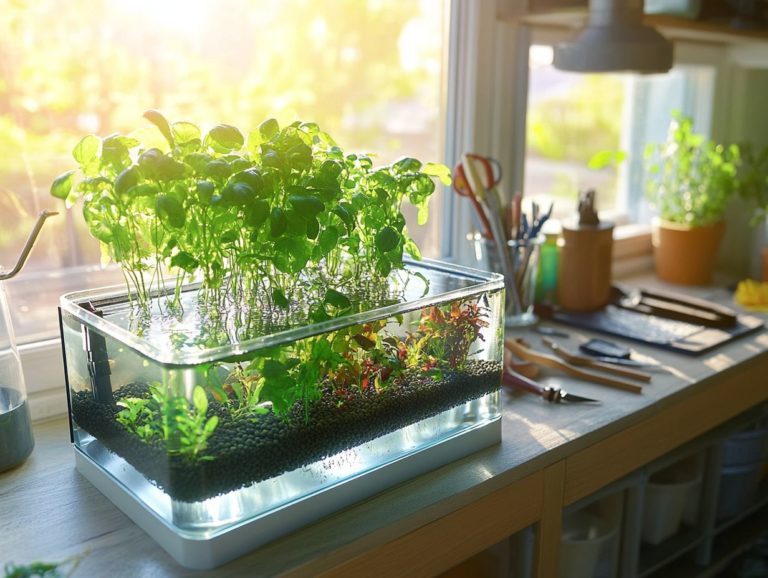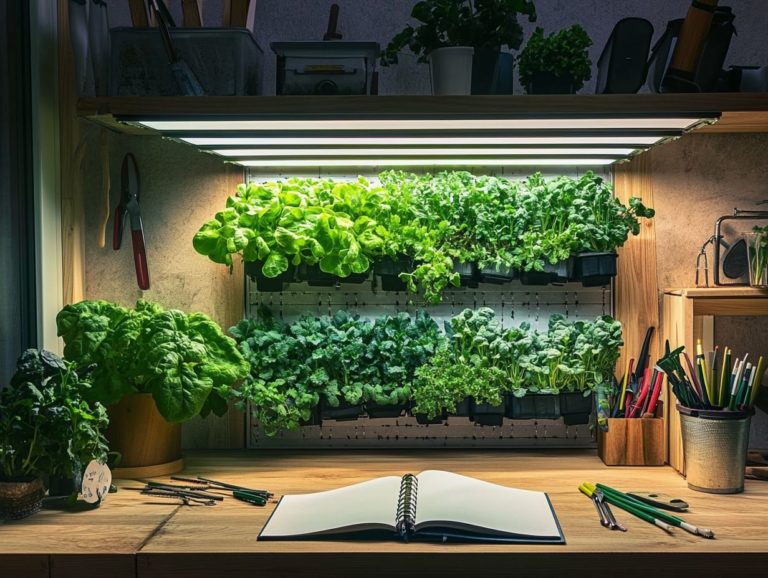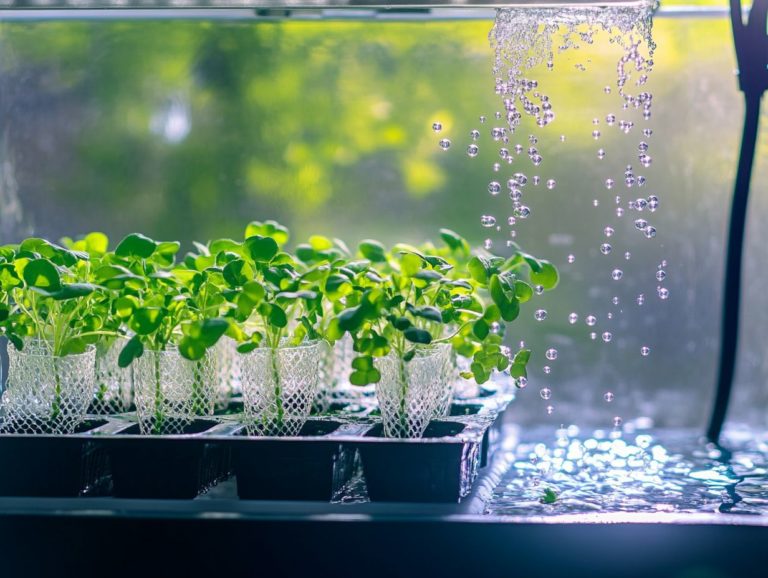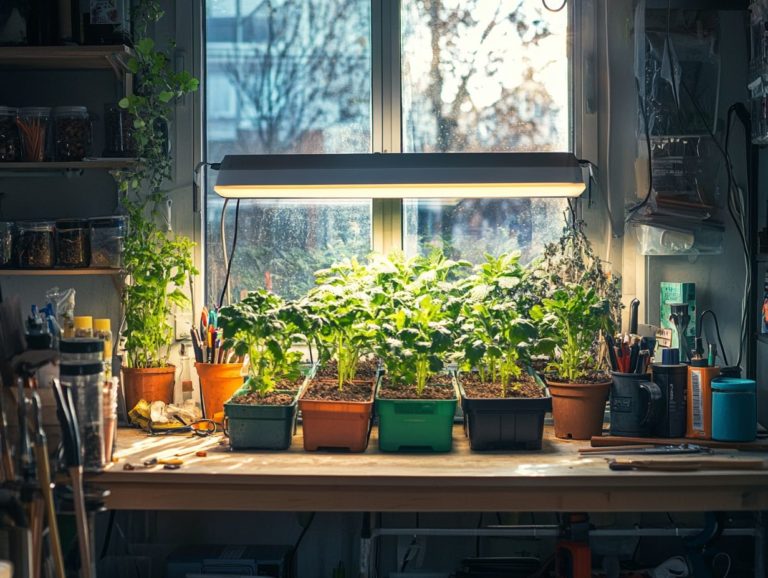How to Make a Hydroponic Grow Box
Curious about growing plants without the hassle of traditional soil? A hydroponic grow box might just be the solution you ve been seeking.
This exciting new system lets you easily grow your favorite plants! Explore the myriad benefits of hydroponic gardening as you weigh the pros and cons of DIY versus pre-made options.
You ll find guidance on the essential materials and tools required for your setup, including air pumps and net pots.
Furthermore, you ll receive a comprehensive step-by-step assembly guide, maintenance tips, and expert advice on selecting the best plants for your grow box. Dive in to uncover how you can elevate your gardening experience to new heights!
Contents
- Key Takeaways:
- Benefits of Using a Hydroponic Grow Box
- Types of Hydroponic Grow Boxes
- Materials and Tools Needed
- Step-by-Step Guide to Building a Hydroponic Grow Box
- Caring for Your Hydroponic Grow Box
- Growing Plants in a Hydroponic Grow Box
- Frequently Asked Questions
- What materials do I need to make a hydroponic grow box?
- Can I make a hydroponic grow box without using electricity and still produce organic produce?
- Is it difficult to maintain a hydroponic grow box?
- Do I need previous gardening experience to make a hydroponic grow box?
- How much space do I need to set up a hydroponic grow box?
- Can I grow any type of plant in a hydroponic grow box?
Key Takeaways:
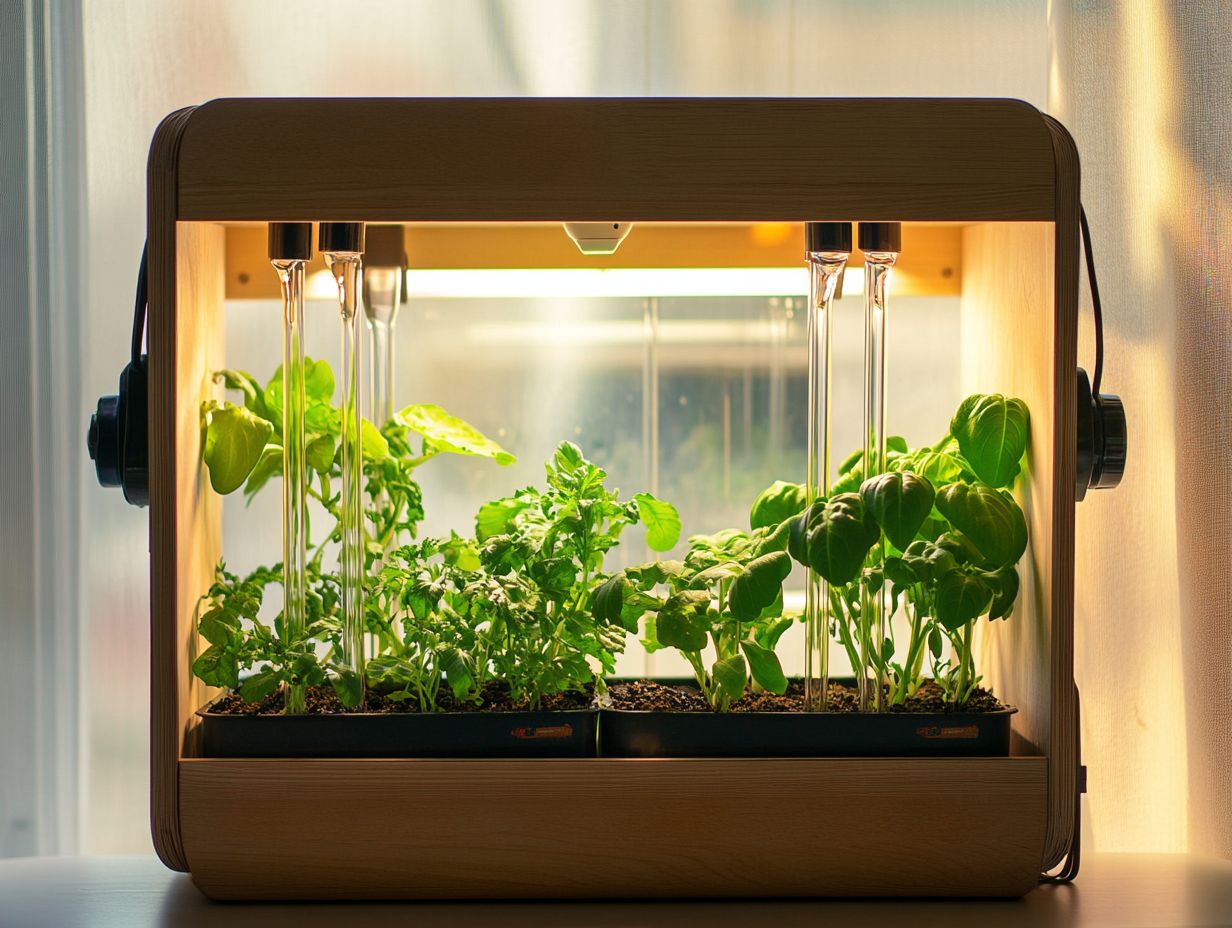
- Save space, time, and water by using a hydroponic grow box.
- Choose between DIY options or buy a ready-made grow box!
- Essential components and proper care are crucial for successful plant growth.
What is a Hydroponic Grow Box?
A hydroponic grow box is your ticket to an innovative indoor farming experience, allowing you to cultivate plants particularly vegetables and herbs without the need for soil. Instead, it utilizes nutrient-rich water, a mix of water and nutrients plants need to grow, enabling you to achieve better results compared to traditional gardening methods.
By effectively managing conditions such as pH levels, light spectrum, and aeration, you can transform your home into a thriving garden oasis. Square Mile Farms in London is a prime example of this urban farming revolution, where individuals like you can embrace sustainable living by growing organic produce in limited spaces.
Equipped with essential components, including a reservoir for the nutrient solution, a pH meter to keep tabs on acidity, and specialized grow lights to deliver the perfect light spectrum, this system gives you the power to create an ideal environment for plant growth. Unlike conventional gardening methods that rely on soil quality and unpredictable weather, a hydroponic grow box allows for year-round cultivation. If you’re interested in getting started, check out this guide on how to start a hydroponic herb garden, making it ideally suited for urban dwellers.
This method not only maximizes your available space but also minimizes water usage, aligning seamlessly with the eco-friendly practices championed by organizations like Square Mile Farms. By adopting this approach, you can cultivate a self-sufficient lifestyle right in the heart of the city.
Benefits of Using a Hydroponic Grow Box
Utilizing a hydroponic grow box presents a wealth of advantages for home gardeners and urban farmers alike. You can experience enhanced efficiency in food production while enjoying the luxury of growing fresh produce throughout the year, all irrespective of the climate outside.
Hydroponics grants you superior control over nutrient delivery, resulting in healthier, more flavorful vegetables and herbs. This approach not only fosters sustainable living but also diminishes your dependence on store-bought options.
Advantages Over Traditional Gardening
Hydroponics offers numerous advantages over traditional gardening, particularly when it comes to maximizing efficiency in space and resource management. By adopting systems like Deep Water Culture, you can optimize your crop selection, ensure precise nutrient solutions, and filter water effectively. This leads to healthier plants and higher yields without the common hassles associated with soil-based cultivation.
This innovative method drastically reduces space requirements, allowing urban gardeners like you to cultivate a variety of plants in limited areas such as balconies or small backyards. Hydroponics also lowers water usage by recycling water within the system, making it an environmentally friendly choice.
Traditional gardening often grapples with pesky issues like pests, nutrient depletion, and soil diseases, which can hinder growth and yield. In contrast, hydroponic systems eliminate these concerns, creating a worry-free environment where your plants can truly thrive.
The efficiency and productivity of hydroponic gardening make it a compelling alternative for both seasoned horticulturists and those just starting their gardening journey.
Start your hydroponic adventure today and enjoy fresh produce right at home!
Types of Hydroponic Grow Boxes
Hydroponic grow boxes offer a diverse array of types, each meticulously crafted to optimize growing conditions and accommodate various plant types, from Deep Water Culture (DWC) systems to aeroponics.
You have the option to select between DIY hydroponic setups or pre-made solutions, tailored to your experience level and desired results. This flexibility gives you the power to explore urban farming techniques that best suit your lifestyle and ambitions.
Comparing DIY and Pre-Made Options
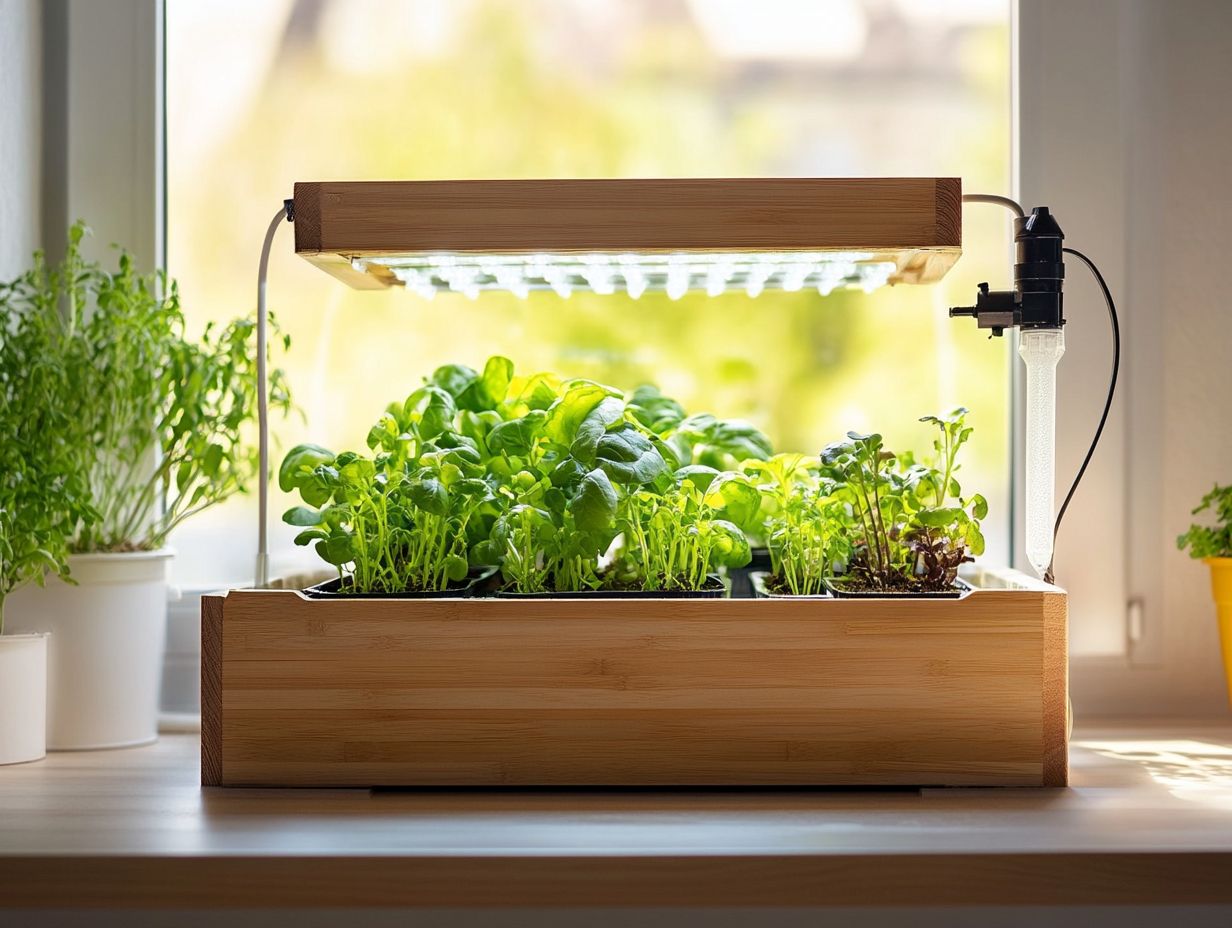
When you re considering hydroponic grow boxes, it s crucial to recognize the significant differences between DIY hydroponic setups and pre-made options. These differences affect your budget and how much you can customize your setup.
Evaluate your needs and maintenance requirements as a home grower.
DIY solutions offer you greater control over design and components, allowing for a tailored experience. On the other hand, pre-made systems bring convenience and ease of use to your gardening journey.
Choosing between these two paths means weighing various factors, such as upfront costs and the level of expertise needed for assembly. DIY systems can often be more budget-friendly, as they frequently use repurposed materials. However, they may require considerable time and effort to set up correctly.
In contrast, pre-made systems come ready to use saving you time but potentially coming with a higher price tag. While DIY setups allow for a customized gardening experience, pre-assembled models might limit your personal touch.
Understanding your gardening techniques helps you make a well-informed decision, ensuring a more fruitful hydroponic experience.
Materials and Tools Needed
Building a hydroponic grow box is exciting and requires the right materials. You ll need essential components like:
- Air pumps to ensure oxygen levels are just right,
- Net pots to provide sturdy support for your plants,
- pH meter (a tool to measure acidity or alkalinity of water) to monitor water quality,
- Rockwool plugs for effective seed propagation.
As a home grower, gathering these key items is crucial before you start your indoor farming adventure.
Essential Components for Building
Key components enhance the efficiency of your hydroponic grow box. You’ll need a storage container for the nutrient solution, an effective airflow system, and suitable materials for germination. Each of these components plays a crucial role in ensuring your plants get just the right amount of nutrients, oxygen, and moisture ingredients vital for healthy growth.
The storage container serves as the reservoir for nutrient-rich water, delivering essential minerals to your plants while minimizing waste. Equally important is the airflow system, which helps regulate temperature and humidity, allowing your plants to transpire and absorb nutrients effectively.
As for germination materials, whether you choose rock wool or coconut coir, they play an essential role in seedling development by retaining moisture while ensuring proper aeration. By understanding how to assemble these elements, you can simplify the growing process and make adjustments that lead to optimal plant health and yield.
Step-by-Step Guide to Building a Hydroponic Grow Box
Creating a hydroponic grow box is an exciting adventure you shouldn t miss! This step-by-step guide equips you with comprehensive instructions for assembly, ensuring your system operates at peak performance.
From choosing the finest materials to mastering essential maintenance practices, this guide streamlines the journey of setting up an efficient hydroponic environment for cultivating vegetables and herbs right at home, including how to make a hydroponic planter with PVC pipes.
Instructions and Tips for Assembly
When you re assembling a hydroponic grow box, following clear instructions and incorporating practical tips can greatly enhance the system s effectiveness. Pay close attention to details like the layout of the components, ensuring proper airflow and nutrient distribution.
It s also wise to prepare for potential troubleshooting as you go along. To achieve optimal performance, arrange all the necessary tools and materials before diving into the assembly.
Check for any missing parts and familiarize yourself with how each component interacts within the system. As you set up, make sure the water reservoir is positioned for easy access, making filling and maintenance a breeze.
If you encounter common issues, such as inconsistent nutrient solution flow or signs of nutrient deficiency in your plants, consider adjusting the pump settings or recalibrating the pH levels. Consistently monitoring environmental conditions is crucial for cultivating a thriving hydroponic garden.
Caring for Your Hydroponic Grow Box
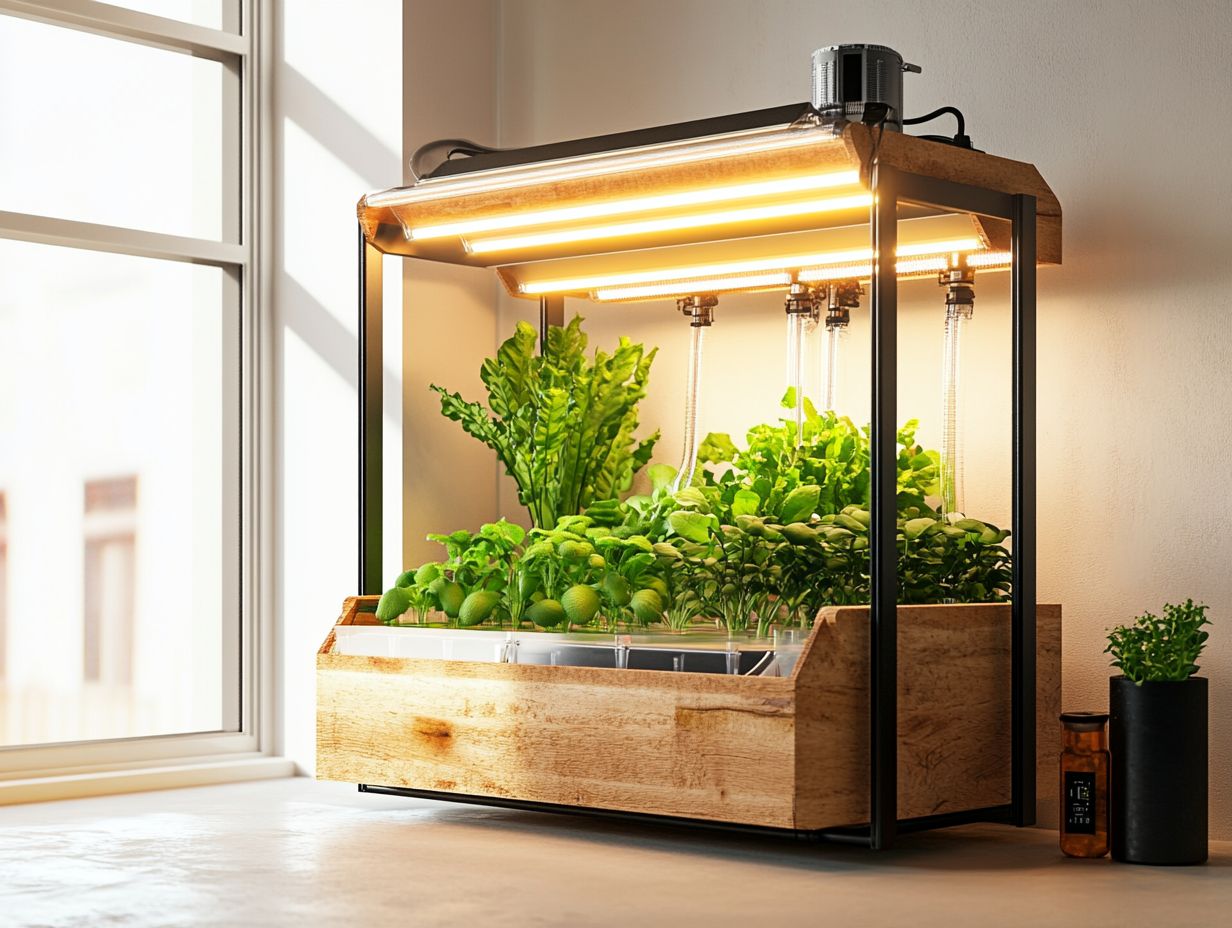
Caring for your hydroponic grow box and optimizing food production is essential for plant health and producing fresh produce and yield. It demands your attention through regular monitoring and a commitment to essential maintenance tasks.
This includes maintenance of the air pump for optimal oxygen replenishment. Keep a close eye on nutrient solution levels, use a pH meter for accuracy, and ensure that all components of the system, such as the grow chamber and air pumps, are functioning seamlessly to create the perfect growing environment. For those interested in expanding their hydroponic skills, check out this guide on how to make a hydroponic system for peppers.
Maintenance and Troubleshooting
Regular maintenance and troubleshooting are essential for the longevity and productivity of your hydroponic systems like Deep Water Culture (DWC). These practices help you create optimal conditions for plant growth.
Key tasks involve monitoring nutrient solution levels and ensuring proper oxygen replenishment. Maintaining an adequate ventilation system and addressing any technical issues promptly can prevent negative impacts on your hydroponic grow box.
Routine checks of pH levels, using a solution to lower pH levels if necessary, are critical. Imbalances can hinder nutrient uptake and cause stress to your plants.
Keeping the water temperature within an ideal range significantly influences maximizing growth potential. It s crucial to clean filters and components regularly, including the water filtration system, to minimize the risk of pathogen build-up.
Common troubleshooting issues often relate to pump malfunctions or equipment failures, such as those involving net pots. Recognizing these early can save you both time and resources.
By implementing these maintenance strategies and considering DIY hydroponic techniques, you can create an amazing hydroponic environment that will flourish with health!
Growing Plants in a Hydroponic Grow Box
Growing vegetables and herbs in a hydroponic grow box requires you to be intentional about your crop selection and to grasp the distinct needs of each plant type for optimal growth and yield.
As a home grower, especially in urban farming, you have the opportunity to cultivate a diverse array of leafy greens, vegetables, and herbs, including microgreens. By meticulously tailoring your growing conditions and nutrient solutions, you can align with the specific requirements of your selected crops.
With the right approach and proper gardening techniques, your hydroponic garden can thrive, offering you a bountiful harvest of organic produce.
Choosing and Cultivating Plants
Choosing and nurturing plants for hydroponic systems demands a discerning eye for the varieties that flourish in nutrient-rich water and adapt to the distinct light spectrum provided by grow lights. Leafy greens like lettuce and vibrant herbs such as basil and parsley are prime candidates for your hydroponic garden. You can enhance your home gardening experience through techniques like seed propagation, plant cuttings, and even rockwool plugs. These methods will help you establish healthy crops that thrive in this innovative environment.
Consider adding crops like spinach and kale to your repertoire. These varieties adapt beautifully to hydroponic conditions and offer the benefit of continual harvests for your kitchen gardening needs. If you’re interested in starting your own system, check out this guide on how to start DIY hydroponic gardening today. When selecting your plants, weigh factors such as growth rate, nutrient requirements, and light needs. Remember that leafy greens typically need less light than fruiting plants, making them ideal for those with limited space or resources, especially in urban growing communities.
Keep your plants thriving by regularly checking pH levels with a pH meter and mixing in hydroponic nutrients. This diligence allows you to reap a diverse and bountiful harvest throughout the year, transforming your gardening journey into a rewarding experience at home.
Frequently Asked Questions
What materials do I need to make a hydroponic grow box?
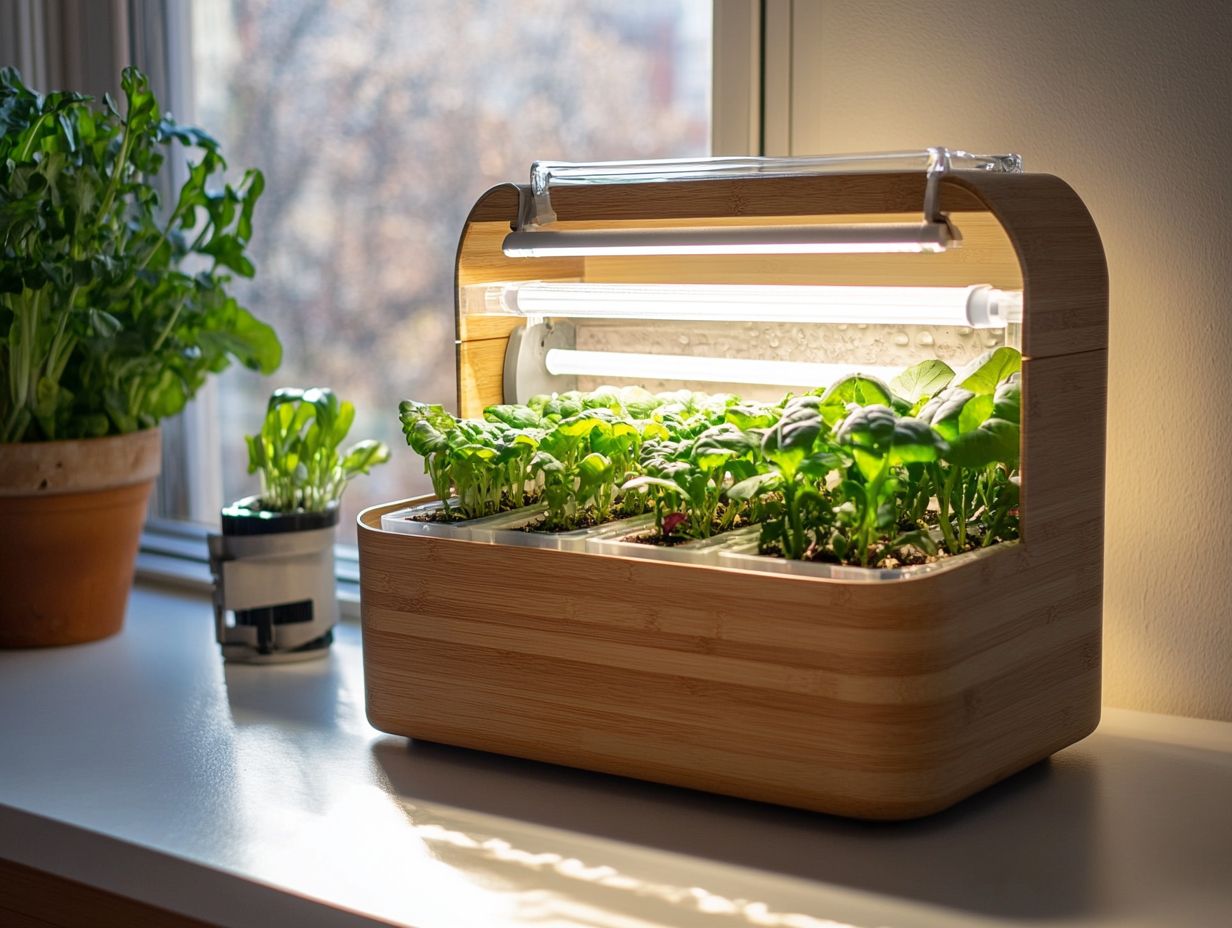
- Plastic storage container
- Net pots
- PVC pipes
- Air pump
- Water pump
- Grow light
- Growing medium
- Nutrient solution
Can I make a hydroponic grow box without using electricity and still produce organic produce?
Yes, you can create a hydroponic grow box without electricity by using a gravity-fed system instead of a water pump, making it an eco-friendly option for sustainable living.
Is it difficult to maintain a hydroponic grow box?
No, maintaining a hydroponic grow box is relatively easy. Regularly check and adjust the nutrient mix and water levels, and clean and maintain the system, including the air pumps and filtration components.
Do I need previous gardening experience to make a hydroponic grow box?
No, you do not need prior gardening experience to create a hydroponic grow box. With just some basic gardening tips, the process is simple and can be learned through research and practice, especially via online resources from urban farming communities.
How much space do I need to set up a hydroponic grow box?
A hydroponic grow box can be set up in a small space, like a closet or spare room, making it perfect for container gardening enthusiasts. The size of the box will depend on how many plants you want to grow, particularly if you aim to maximize indoor farming space.
Can I grow any type of plant in a hydroponic grow box?
Yes, you can grow a variety of plants in a hydroponic grow box, including vegetables, herbs, microgreens, and flowers. Just ensure you research the specific needs and requirements of each plant beforehand, including their light spectrum and nutrient needs.
Start your hydroponic garden today and enjoy fresh produce right at home!

